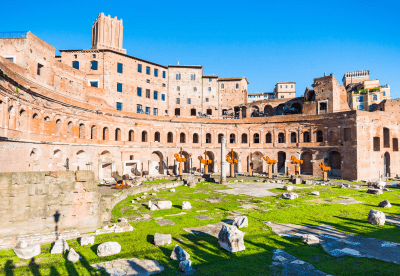What is Trajan's Market?

Trajan's Market is the modern-day name given to a public complex built by the Roman emperor Trajan in the Roman Forum.
Completed in 112 AD, it consisted of the ancient equivalent of a multi-storey shopping mall, as well as government offices and living accommodation.
It is difficult to fully understand, in modern terms, the significance of the Forum in ancient Roman society. It is often described as a simple bazaar, but this central city plaza was the hub of all activity in the ancient city of Rome.
The Roman Forum was a marketplace of commerce, but it would also house government buildings and business offices, serve as the setting for criminal trials or political elections, and was generally the place where the movers and shakers of the day could forge connections and climb the social ladder.
The Construction of Trajan's Forum & Trajan's Market
Over the centuries, various Roman emperors rearranged or changed the Forum in testament to their own accomplishments. The last of these was ordered by the great Roman Emperor Trajan and completed in 112 AD after he had successfully conquered the Kingdom of Dacia, located in present-day Romania. It was a massive renovation that included the construction of an entirely new commercial complex that historians call Trajan's Market.
This marketplace was to be a new addition to the Roman Forum that would be built into the slope of a hill on one side of the Forum, but separated from the rest of the square by a large wall. It was composed of three different levels as it rose against this natural incline.
This ambitious design project was most likely the vision of Apollodorus of Damascus, the renowned ancient architect who oversaw the renovation of the Forum itself.
The complex was built using sophisticated methods and materials, such as concrete and brick, that represent the pinnacle of Imperial Roman architecture and construction technology.
Elements of Trajan's Market
While history has named the complex 'Trajan's Market', it was, as mentioned above, actually a public complex with multiple uses.
First, there was a very large marketplace square on the ground level that faced the busy street on the edge of the Forum. This space was filled with small alcoves that were lined with travertine stone and set into the semi-circular facade of the building, with more alcoves on the second level directly above that. These recesses were designed so that individual merchants could set up shops and display their goods to the masses that would pass by. For this reason, many historians have referred to Trajan's Market as the world's first shopping mall.
On the second and third levels of the complex were additional arcades, or series of consecutive arches, that also provided alcoves. While it was initially thought that these arcades were an extension of the marketplace below, historians now believe that these were actually administrative offices that were used by Emperor Trajan's government for activities such as state commerce and other local policy matters.
Finally, on the third level of Trajan's Market, there was a large central building that served as an apartment complex. This would create a desirable residential space directly next to the bustling commercial and cultural center of the Market and the Forum in general. This urban design, which is very common in cities all over the world today, shows just how culturally-advanced the city of Rome was at this stage in its history.
Trajan's Market in Post-Roman Times and Today
When Rome was sacked by the Visigoths in 410 AD, the city fell into a state of decline that would leave engineering marvels such as Trajan's Market forgotten and left relatively abandoned for centuries.
However, with the rise of the Papacy in the Middle Ages, the city again became a nexus of political power, leading to a transformation of the Market into a medieval fortress in approximately 1200 AD. To serve this purpose, many additions were made, including a huge defense tower called the Torre dela Milizie.
The following centuries would see the Market used as a convent and a military barracks, until it was purchased by the modern nation of Italy in the early 20th century, leading to its archaeological excavation.
Today, many portions of Trajan's Market can still be seen in the modern city of Rome. They have been painstakingly uncovered and partially restored, so that they can be displayed as part of the city's amazing cultural heritage. It is open to the public and houses the Museum of the Imperial Forums, which contains artifacts from many different periods in the history of the Roman Forum.
Like many ancient Roman ruins, it remains an imposing testament to Roman power and influence, despite being nearly two thousand years old.
Related Page:



